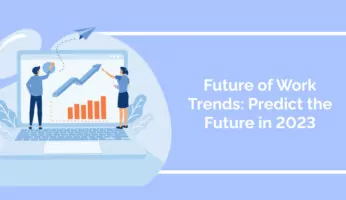
Change management – ready or not?
The future is coming quickly and the pace of change is accelerating with every passing year. Now more than ever, it is crucial for organizations to future-proof their workflows, the workforce, and the workplace.
Future-proofing the organization, however, will often require significant change.
To successfully implement these changes, it is important to take a structured approach to change management.
Below, we’ll look at the current state of the business landscape, why change management is so important, and techniques for future-proofing the business.
The Challenge of Continuous Change
In today’s economy, change is the only constant.
Digital technology is one of the biggest drivers of change in the modern world. Technology-driven innovation, for instance, has fueled the growth of new industries, as well as the downfall of others.
Alongside the digital revolution, we also have other changes that stem from natural processes, such as geopolitical change and the process of time.
Also, in 2020, these natural processes of change have been further accelerated by COVID-19. Many analysts, for instance, have pointed out that the pandemic actually propelled the adoption of new digital technologies and processes.
While change certainly presents new opportunities for businesses, it also presents a number of challenges.
In this type of environment, for instance:
- Organizations must become agile and adaptable to keep up with today’s changing business world
- Businesses should adopt new digital tools and processes to compete in the digital-first economy
- Employees must become digitally skilled in order to stay productive in today’s workplace
In short, continuous change presents employers with a range of new challenges. Overcoming these challenges will require a variety of tactics and approaches, but one of the best ways to future-proof the organization is change management.
Change Management: Ready or Not?
Change management is the business discipline dedicated to implementing and overseeing organizational change projects.
In an era defined by constant change, it is more important than ever to take a structured approach to change management.
There are several benefits to implementing a well-structured and sophisticated change management strategy, including:
- Better project outcomes
- Higher ROI
- Smoother project execution
- Shorter project timelines
- Lower resistance from employees
- Greater employee productivity
Ultimately, change management boosts organizational performance and agility – necessities for any forward-thinking organization.
Yet taking a structured approach to change is only the first step towards future-proofing the organization.
The next logical question is: how exactly should the organization be changed?
Top Priorities for the Future-Proofed Business
To overcome the challenges mentioned above and stay ready for tomorrow’s digital future, it is important to focus on a few agenda items.
Here are some of the most important priorities to focus on:
Agility and Innovation
In an economy driven by change, agility is a prerequisite for success.
This has been true for quite a while, and as we have seen in recent years, the rate of change is only increasing.
Many analyst firms suggest that economic volatility will continue well into the post-COVID next normal – and some suggest that we will face even more uncertainty in the years ahead.
Agility, therefore, should become a top priority for organizations.
On the one hand, becoming agile means implementing a formal change management function in the organization, as mentioned above.
But becoming agile also means that companies should rethink their organization’s business processes and their revenue models, putting agile practices at the core.
Agile business processes, for instance, are designed around principles such as:
- Customer-centrism and user-centrism
- Continuous collaboration
- Responsiveness over static processes
After all, in volatile economic environments, only the most innovative and agile businesses will survive.
The Digital-First Business
Just as agility is necessary to compete in a volatile economy, competing in the digital world depends on digital savviness.
This means:
- Business models and revenue models should leverage technology as much as possible
- The workplace itself should be built upon digital tools and workflows
- Organizations should continually research and adopt emerging technology
- Employees must be well-trained and digitally capable
The digital business, in other words, is the building block of the digital economy.
Companies should therefore prioritize digital maturity and digital transformation when future-proofing their business.
A New Organizational Culture
Organizational culture can have a significant impact on organizational change programs.
This is not always the case, of course. In some cases, culture may be neutral and have no discernible impact on a change effort.
However, in today’s fast-paced world, certain cultural traits can be beneficial, such as:
- A pro-learning mindset
- Self-reliance
- Openness to change and new ideas
- Digital savviness
These types of cultural traits can help an organization stay agile, innovative, and change-ready.
Resilience is another reason to consider investing in organizational culture change. As we saw in 2020, for instance, the most resilient businesses were those with agile, digital-friendly cultures.
WalkMe Team
WalkMe spearheaded the Digital Adoption Platform (DAP) for associations to use the maximum capacity of their advanced resources. Utilizing man-made consciousness, AI, and context-oriented direction, WalkMe adds a powerful UI layer to raise the computerized proficiency, everything being equal.



